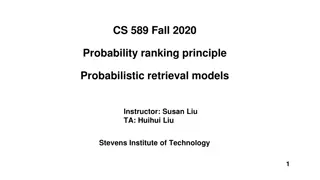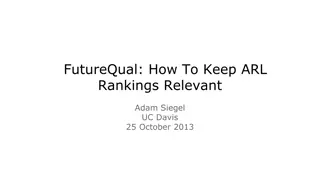
University Rankings: Dimensions and Impact
Explore the world of university rankings and their influences on recruitment, funding, and reputation. Learn about international and domestic ranking systems, positive and negative aspects, and the challenges of data accuracy and presentation.
Download Presentation

Please find below an Image/Link to download the presentation.
The content on the website is provided AS IS for your information and personal use only. It may not be sold, licensed, or shared on other websites without obtaining consent from the author. If you encounter any issues during the download, it is possible that the publisher has removed the file from their server.
You are allowed to download the files provided on this website for personal or commercial use, subject to the condition that they are used lawfully. All files are the property of their respective owners.
The content on the website is provided AS IS for your information and personal use only. It may not be sold, licensed, or shared on other websites without obtaining consent from the author.
E N D
Presentation Transcript
Palestine Polytechnic University Center for Excellence in Teaching and Learning University Ranking System Adnan Shehadeh & Hasan Sawalha 25/09/2018
Introduction Main reasons is competition: recruit students Secure research funding Enhance prestige
Main International Ranking 1. The World University Ranking by Times Higher Education (THE) 2. The QS World University Ranking by Quacquarelli Symonds Ltd (QS) 3.The Academic Ranking of World Universities by Shanghai Jiao Tong University (ARWU) 4. U-Multirank, by Consortium of 4 universities centers funded by EU led by Center for Higher Education in Germany (CHE)
International Rankings: dimensions, indicators and weights
Examples of domestic rankings, dimensions of excellence, indicators and weights
Jordanian University Ranking System 1. Teaching & Learning 250 points 2. Scientific Research 250 points 3. Internationalization 150 points 4. Quality of graduates 200 points 5. Academic accreditation 150 points It includes 29 performance indicators.
Positive vs. Negative Positive 1.Provide information to potential students. 2. Provide information to policymakers and stakeholders. 3.Provide benchmark information for universities. 4. Stimulate improvement as a result of benchmarks and incentives.
Negatives 1. The impact of rankings: the effect on the decisions of governments and universities.(France, Germany, Russia, China) 2. The data : if the data is not strong and correct, the ranking will be the same. 3. The way rankings are presented- from best to worst. 4. Choice of appropriate weight.( mainly Research)
Problematic issues (Research dominant) 1. They measure mainly research performance.(surveys of reputation, employers) Academic staff to student ratio as an indicator of teaching quality. (reflects research issues) 3. Commercial in come largely because of research. 4.International staff is a almost about research( recruiting researchers) 5. The proportion of PhD students is also research related. 6.The number of Nobel Prize winners-Research. Research account for 85% of THE and QS and 100% of ARWU. 2. This drives universities to focus on research on the expenses of teaching. This is appropriate for small number of universities.
Data issue Terminology and definitions: 1. Apart from publications and citations, The only source for information is university. 2. No clear definitions of the terms, students, full-time staff, graduate. 3. No auditing of the provided data. (Ttrinity College Dublin, Sultan Qaboos University) 4. In reputation surveys (represent 50%-30% weight), the response is less that 10%.
Conclusions The research shows that: 1. Ranking is almost entirely based on research- related criteria. 2. If universities want to move up, they must focus on research on the expenses of teaching and other activities. 3. The used data is of doubtful quality. 4. It urges the governments and universities to ignore rankings when making decisions and to do what they do because it is right, not because it will impact performance in rankings
Reference Bekhradnia, B. 2016. International University Ranking: For Good or Ill?. Higher Education Policy Institute. Oxford.






















